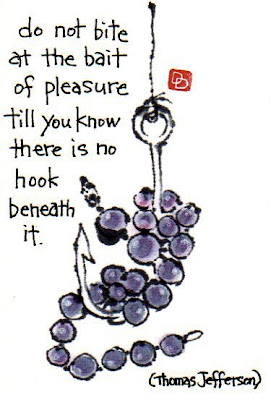 The message gives the traditional New Year greeting with the addition of a private message to me. The image depicts one of the seven lucky gods that is referred to a lot at this time of year.
The message gives the traditional New Year greeting with the addition of a private message to me. The image depicts one of the seven lucky gods that is referred to a lot at this time of year. Shows tiger (2010 zodiac) turning into a rabbit (2011 zodiac). Printed words translate roughly to "Having long ears doesn't make you a rabbit." In his private message, the artist says he's resolved to quit pretending to be other than what he is.
Shows tiger (2010 zodiac) turning into a rabbit (2011 zodiac). Printed words translate roughly to "Having long ears doesn't make you a rabbit." In his private message, the artist says he's resolved to quit pretending to be other than what he is. This lino-cut rabbit is accompanied by the words: "May this year be full of happy things." The artist is a certified etegami instructor and reminds me time and time again that the best etegami is simple and childlike.
This lino-cut rabbit is accompanied by the words: "May this year be full of happy things." The artist is a certified etegami instructor and reminds me time and time again that the best etegami is simple and childlike. Rabbit and carrot etegami with "Beginning of Spring" in gold ink. This is another common way to refer to the New Year. Even if the cold and snow continues for many months, New Years Day is when we rejoice in the expectation of Spring and in new beginnings.
Rabbit and carrot etegami with "Beginning of Spring" in gold ink. This is another common way to refer to the New Year. Even if the cold and snow continues for many months, New Years Day is when we rejoice in the expectation of Spring and in new beginnings.
This is the second year I've receive a nengajou from this artist, and once again she has delighted me with her creative ideas. The card is overlaid with soft, fluffy, wrinkled washi paper and stamped with an utterly adorable bunny seal. On the other side is her greeting: "Happy Fluffy New Year!"
 I've come to expect gorgeous colors & fine technique from this etegami artist, and this nengajou does not disappoint. The words are one more version of the traditional New Year greeting done in strokes oozing with character.
I've come to expect gorgeous colors & fine technique from this etegami artist, and this nengajou does not disappoint. The words are one more version of the traditional New Year greeting done in strokes oozing with character. This nengajou is from a new etegami friend whose work has been posted several times on my mailart gallery blog. It may be hard to see, but the gold ink added to the bunny and the waves conveys wishes of good fortune and happiness. The accompanying words say "With a Fresh/Renewed Heart and Mind."
This nengajou is from a new etegami friend whose work has been posted several times on my mailart gallery blog. It may be hard to see, but the gold ink added to the bunny and the waves conveys wishes of good fortune and happiness. The accompanying words say "With a Fresh/Renewed Heart and Mind."It is already New Year's Day in Japan, despite what date might appear at the top of this post. The mailman delivered the first batch of New Year cards, presumably the ones that were posted before the Dec 24th deadline. Cards from those who mailed theirs after the deadline (that includes me :p) will trickle in during the next few days. I'll post more soon. : ) To learn more about the Japanese tradition of exchanging New Year postcards, check out this post from last year.








































































